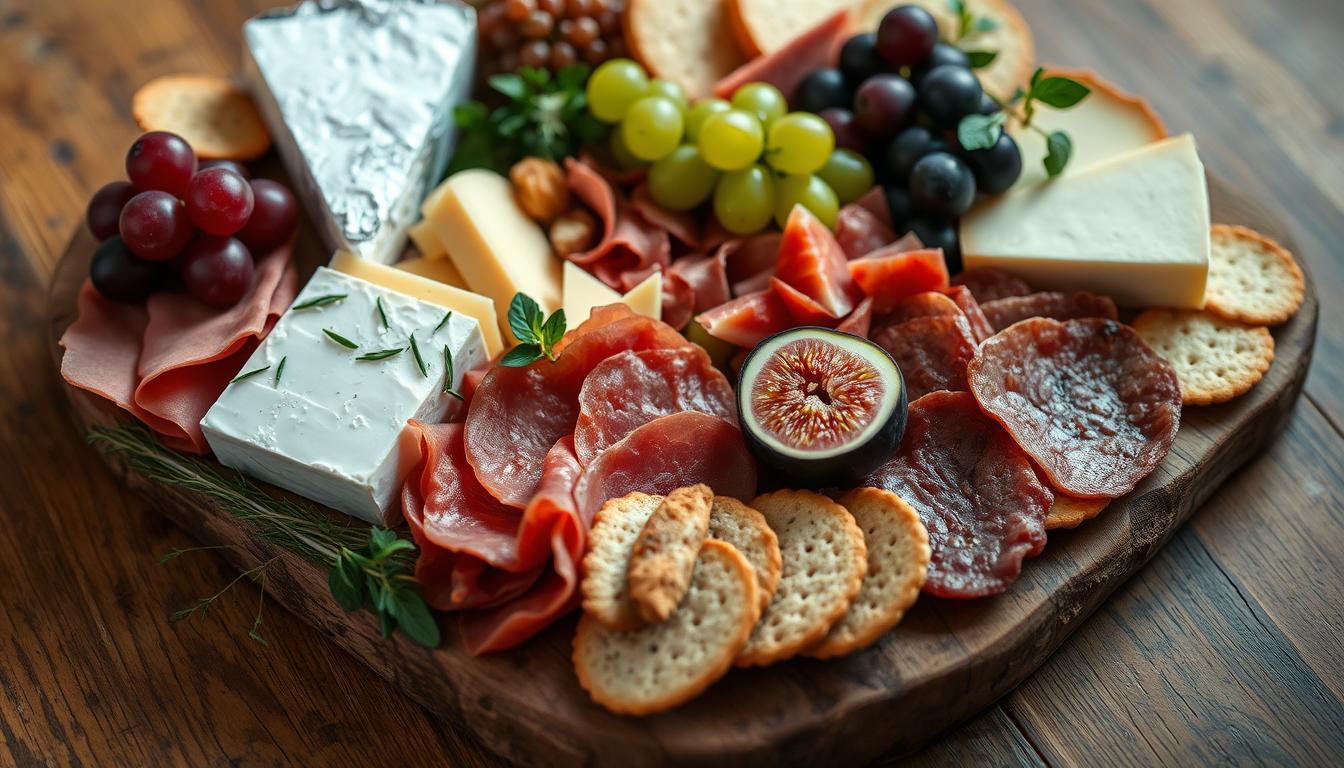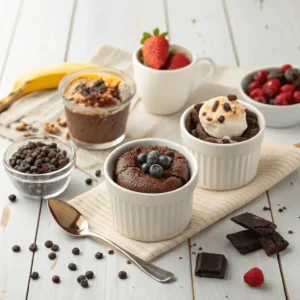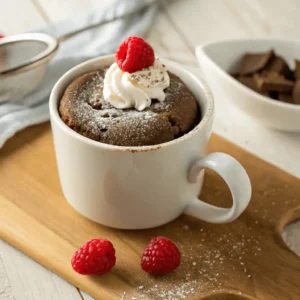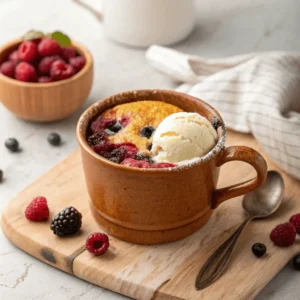Charcuterie box lunch recipes are a trendy, tasty way to eat well on the move. They mix cured meats, cheeses, fruits, nuts, olives, and more. This mix comes from France and has become a fancy, flexible lunch choice for any time.
This guide will show you how to make amazing charcuterie box lunches. Impress your coworkers, make your kids happy, and satisfy your hunger. You’ll learn how to pick the best ingredients and put them together for a gourmet meal.
Key Takeaways
- Charcuterie box lunches are a trendy and convenient way to enjoy a balanced, portable meal.
- These lunches typically feature a variety of cured meats, artisanal cheeses, fresh and dried fruits, crunchy nuts, and savory accompaniments.
- Charcuterie box lunches have French origins but have evolved into a modern, customizable lunch option.
- Assembling these lunches requires a careful selection of high-quality ingredients and thoughtful presentation.
- Charcuterie box lunches can be adapted to suit individual tastes, dietary needs, and seasonal variations.
Understanding the Art of Charcuterie Box Lunches
Charcuterie is pronounced, “shahr-kyu-tuh-ree.” It comes from the French term for “pork-butcher shop.” Today, it includes many foods, making it a favorite for lunch.
The French Origins of Charcuterie
In France, charcuterie started with curing meats. Artisans made everything from strong salami to thin prosciutto. These meats are key in French food and culture.
Modern Interpretations for Lunch Boxes
Now, Mediterranean lunch ideas include more than just meats. You’ll find cheeses, fruits, nuts, olives, crackers, and spreads. This mix of foods is both tasty and healthy.
Essential Components of a Balanced Box
- Cured meats, such as salami, prosciutto, and soppressata
- Artisanal cheeses, like Brie, Manchego, and Gouda
- Fresh and dried fruits, such as grapes, figs, and apricots
- Crunchy nuts, including almonds, cashews, and pistachios
- Briny olives and flavorful spreads, like hummus or tapenade
- Crisp crackers or artisanal breads
These charcuterie pronunciation items make a lunchbox that looks good and is good for you. It suits many tastes and diets.
Essential Tools and Equipment for Assembly
Creating tasty charcuterie box lunches is easier with the right tools. You’ll need sturdy lunch containers and special cheese knives. These essentials will make your charcuterie look great and make it easy to put together.
A lunch container with many compartments is a must. Choose ones with tight lids and seals to keep food fresh. For sauces and small items, use separate containers that fit in your lunch box.
- Sturdy lunch container with compartments
- Small, leak-proof food containers for sauces and dips
- Cheese knives in various sizes to handle soft and hard cheeses
- Toothpicks or small forks for skewering and serving
- Reusable silicone bags or beeswax wraps for wrapping individual items
- Insulated lunch bag to keep your charcuterie box fresh and at the ideal temperature
A good insulated lunch bag is key to keeping your charcuterie box fresh. Look for durable and well-insulated bags. They’ll keep your box cool and ready to eat.
| Charcuterie Board Tools | Lunch Box Essentials | Meal Prep Equipment |
|---|---|---|
| Cheese knives | Compartmentalized lunch container | Insulated lunch bag |
| Toothpicks or small forks | Leak-proof food containers | Reusable silicone bags |
| Cutting board | Beeswax wraps | Compact wine opener |
With the right tools, you’ll make charcuterie box lunches that wow. They’ll impress your colleagues or loved ones.
Selecting Quality Meats for Your Charcuterie Box
Choosing the right cured meats is key for a great charcuterie box. From prosciutto to chorizo, each meat adds a special flavor. Try different Mediterranean diet recipes and pick a variety of cured meats for a tasty and beautiful lunch.
Cured Meat Varieties
Start with classics like prosciutto, salami, and ham. Then, try unique meats like Spanish chorizo or Italian capicola. Mix familiar and new meats to please everyone’s taste.
Proper Storage and Handling
Keeping your charcuterie box safe is crucial. Always store meats in the fridge and eat them before they expire. Handle the meats carefully to keep them fresh and safe.
Portion Control Guidelines
For each person, use 2-3 ounces of meat. Arrange the meats in a pretty way, like fans or rosettes. This makes your box look great and helps with portion sizes.
| Cured Meat Variety | Recommended Serving Size | Shelf Life |
|---|---|---|
| Prosciutto | 2-3 ounces | 3-4 weeks refrigerated |
| Salami | 2-3 ounces | 2-3 weeks refrigerated |
| Chorizo | 2-3 ounces | 1-2 weeks refrigerated |
| Capicola | 2-3 ounces | 3-4 weeks refrigerated |
By choosing and handling your cured meats well, your charcuterie box will be both beautiful and safe to eat.
Perfect Cheese Pairings for Lunch Boxes
Choosing the right cheese for your charcuterie box lunch is crucial. Mix both hard and soft cheeses for a delightful taste. Try Manchego for its creaminess, aged cheddar for sharpness, brie for richness, and goat cheese for tanginess.
Pair your cheeses with meats for a balanced taste. A spicy chorizo goes well with soft cheeses like mozzarella. Aged cheddar or Gruyère pairs well with mild meats like prosciutto or salami.
Feel free to try new cheese and meat combinations. Honey on brie or nuts on Manchego can elevate your lunch. Add olives, pickles, and crackers for a complete Mediterranean lunch.
| Cheese Variety | Recommended Pairings |
|---|---|
| Soft Cheeses (Brie, Camembert, Goat Cheese) | Prosciutto, Salami, Honey, Dried Fruit |
| Semi-Soft Cheeses (Mozzarella, Havarti) | Salami, Pepperoni, Olives, Roasted Red Peppers |
| Hard Cheeses (Manchego, Aged Cheddar, Gruyère) | Chorizo, Capocollo, Nuts, Dried Figs |
| Blue Cheeses (Stilton, Gorgonzola) | Prosciutto, Walnuts, Honey, Dried Cranberries |
With the right cheese and meat pairings, your charcuterie box lunch will be both tasty and beautiful. It will satisfy your hunger and energize your day.
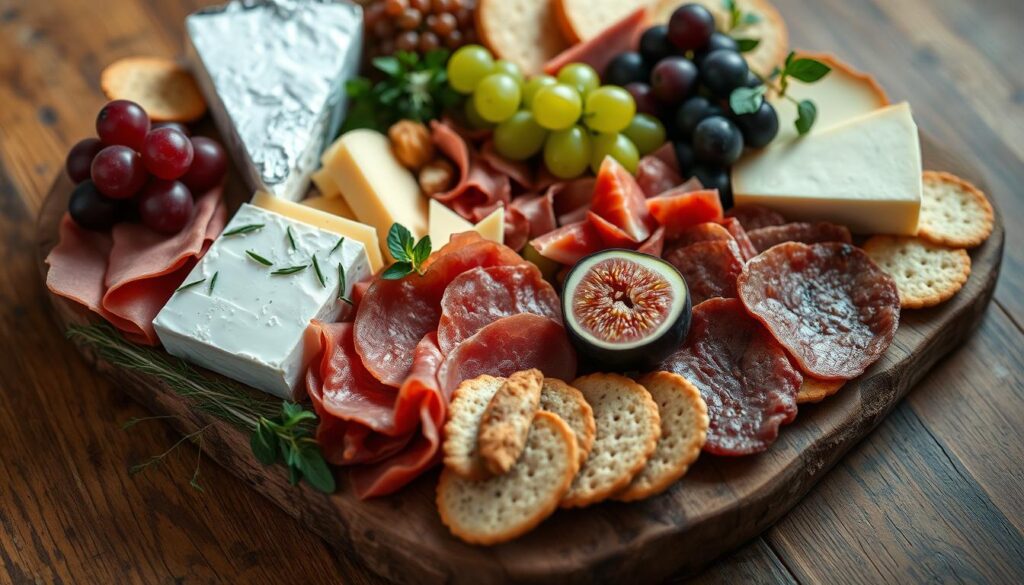
Fresh and Dried Fruit Combinations
Make your charcuterie box lunch special with fresh and dried fruits. Add juicy grapes, crisp apple slices, and sweet pears for color and sweetness. Mix in dried apricots, figs, and cranberries for a tasty and chewy snack.
Seasonal Fruit Selection Guide
Choose a mix of seasonal fruits for your charcuterie box. In spring, pick strawberries, blueberries, and oranges. Summer brings watermelon, peaches, and blackberries. Autumn is perfect for pears, apples, and pomegranate arils.
Creative Fruit Arrangements
Get creative with your fruit arrangement. Group grapes, fan out apple and pear slices, and scatter berries. Try a fruit mosaic or a geometric fruit layer for a stunning look.
Storage Tips for Maximum Freshness
Keep fruits fresh by storing them separately. Use lemon juice on cut fruits like apples and pears. Store dried fruits in an airtight container at room temperature. Refrigerate fresh fruits until serving.
| Fruit Type | Seasonal Availability | Suggested Pairings |
|---|---|---|
| Grapes | Year-round, with peak seasons in summer and fall | Aged cheeses, cured meats, nuts |
| Apples | Fall and winter | Sharp cheddar, gouda, honey |
| Pears | Fall and winter | Brie, blue cheese, walnuts |
| Berries (Strawberries, Blueberries, Raspberries) | Spring and summer | Goat cheese, honey, dark chocolate |
| Dried Fruit (Apricots, Figs, Cranberries) | Year-round | Aged cheddar, blue cheese, nuts |
Charcuterie Box Lunch Recipes for Every Season
Make your lunchtime special with charcuterie boxes for every season. Enjoy a light summer spread or a hearty autumn mix. These recipes bring gourmet flavors right to your desk or on the go.
In summer, add fresh berries, crisp veggies, and tangy cheeses. For fall, include sliced apples, fig spreads, and creamier cheeses. In winter, go for dried fruits, nuts, and bold cheeses. Spring brings fresh herbs, crunchy veggies, and bright cheeses.
Try new things beyond meat and cheese. Add vegetarian Mediterranean dishes with hummus, roasted veggies, and nuts. For more variety, mix in Italian, French, or Spanish flavors.
| Seasonal Charcuterie Box Lunch Ideas |
|---|
| Summer: Fresh berries, light cheeses, cucumber slices, grape tomatoes Fall: Apple slices, fig spreads, cheddar, Brie, dried cranberries Winter: Dried apricots, walnuts, Gouda, salami, olives Spring: Strawberries, fresh herbs, goat cheese, carrot sticks, pea shoots |
These seasonal lunch ideas make every charcuterie box a treat. Mix up flavors and styles to keep your lunches exciting and seasonal.
Incorporating Mediterranean Elements
Make your charcuterie box special with Mediterranean touches. The Mediterranean offers unique flavors and textures. Adding olive varieties and Mediterranean dips and spreads boosts taste and health.
Olive and Antipasto Selections
Olives are key in Mediterranean cuisine. They add a burst of flavor to your charcuterie box. Try different olive varieties like Kalamata or green olives with garlic or feta. Also, include marinated items like artichoke hearts or sun-dried tomatoes.
These items look great and taste amazing. They contrast well with meats and cheeses.
Mediterranean Dips and Spreads
Add healthy dips and spreads to your charcuterie. Hummus, tzatziki, or olive tapenade are great choices. They add flavor and nutrition to your lunchbox.
These Mediterranean appetizers make your meal more enjoyable. They also follow the Mediterranean diet’s healthy eating principles.
| Mediterranean Dip or Spread | Key Ingredients | Flavor Profile |
|---|---|---|
| Hummus | Chickpeas, tahini, olive oil, garlic, lemon juice | Creamy, nutty, and tangy |
| Tzatziki | Greek yogurt, cucumber, garlic, dill, lemon juice | Cool, refreshing, and herbal |
| Olive Tapenade | Olives, olive oil, garlic, anchovies, capers | Salty, briny, and savory |
Adding Mediterranean elements makes your charcuterie box more exciting. It also follows healthy eating guidelines.
Creative Cracker and Bread Options
Make your charcuterie box lunches more exciting with different crackers and breads. Try gluten-free crackers, artisanal breads, and Mediterranean sandwiches. These choices will enhance your meats, and cheeses, and add texture to your lunch.
Gluten-Free Cracker Choices
- Rice crackers: These versatile, crunchy crackers provide a gluten-free base for your charcuterie selections.
- Vegetable crisps: Made from vegetables like beets, kale, or sweet potatoes, these flavorful crackers offer a nutrient-dense alternative.
- Nut-based crackers: Almond flour or cashew-based crackers add a satisfying, protein-rich crunch.
Artisanal Bread Varieties
- Whole grain baguette slices: The robust texture and nutty flavor of whole grain bread pairs beautifully with your charcuterie selections.
- Breadsticks: These long, crispy sticks are perfect for dipping in Mediterranean-inspired dips and spreads.
- Pita chips: Baked or fried pita triangles offer a versatile, crunchy platform for your charcuterie box.
| Cracker Type | Flavor Profile | Suggested Pairings |
|---|---|---|
| Rosemary Olive Oil Crackers | Savory, herbal | Prosciutto, aged cheddar, olives |
| Multigrain Crackers | Nutty, wholesome | Salami, gouda, dried figs |
| Garlic and Herb Breadsticks | Robust, garlicky | Capicola, brie, roasted red peppers |
When you put together your charcuterie box, portion the crackers and bread first. This keeps them fresh and prevents them from getting soggy. With these creative choices, you’ll make your lunchtime charcuterie experience even better. You’ll also satisfy your cravings for gluten-free and artisanal options.
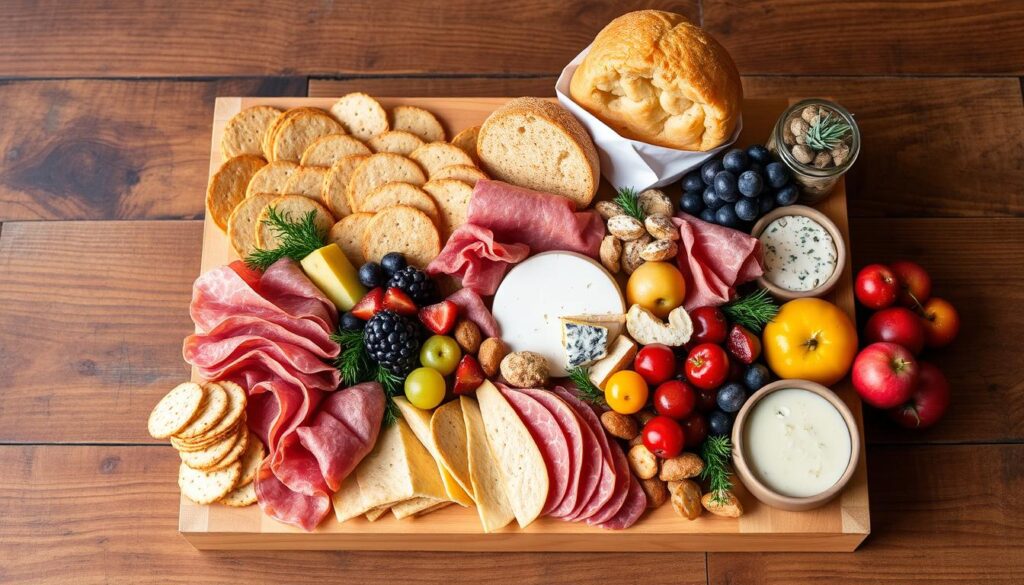
Time-Saving Assembly Tips and Techniques
Creating a tasty charcuterie box lunch doesn’t have to take a lot of time. With some meal prep tips and clever food storage hacks, you can make quick and tasty lunch ideas. These lunches will look great and taste even better.
Prep-Ahead Strategies
Begin by washing and cutting fruits and veggies at the start of the week. Slice cheeses and meats ahead of time and store them in the fridge separately. This saves you time when it’s time to put your charcuterie box together.
Put your dry ingredients, like crackers and nuts, in small containers or silicone cupcake liners. This keeps everything organized and easy to grab when you’re packing your lunch.
Storage Solutions
- Get high-quality, airtight storage containers to keep your charcuterie fresh and prevent flavors from mixing.
- Wrap your charcuterie box in plastic wrap and store it in the fridge overnight. Add fresh items like bread or crackers just before eating.
- Use small divider trays or silicone compartment containers to keep your ingredients separate and organized in your lunch box.
With these time-saving assembly tips and food storage solutions, you can enjoy a wonderful charcuterie box lunch easily. Embrace the ease of meal prep and get ready to enjoy a satisfying and beautiful midday meal.
Presentation and Packaging Ideas
Make your charcuterie box lunches stand out with great presentation and eco-friendly packaging. Focus on the lunch box aesthetics to craft Instagram-worthy lunches. These should look good and be good for the planet.
Begin by arranging your charcuterie items in a beautiful way. Mix colors, textures, and shapes for a stunning display. Roll or fold meats for a fancy look. Keep wet items like fruits and veggies separate from dry ones to keep everything fresh.
Choose eco-friendly packaging like bamboo boxes or reusable cloth wraps. These choices are better for the environment. They also make your charcuterie box look even better.
Include small garnishes like fresh herbs or edible flowers for extra elegance. These small touches can turn your charcuterie into a masterpiece. It will look great and feel wonderful to eat.
The secret to Instagram-worthy lunches is finding the right mix of colors, textures, and tastes. By focusing on how your charcuterie box looks and feels, you’ll make sure it’s both tasty and visually stunning.
Conclusion
Charcuterie box lunches are a great choice for a quick, healthy meal. They mix cured meats, cheeses, fruits, and more. This makes for a tasty and varied lunch that everyone can enjoy.
These lunches are more than just easy to make. They offer a balanced meal that’s good for you. You get to enjoy great flavors and textures, which is good for your health.
Charcuterie boxes can make your lunchtime special. They’re perfect for those who want a simple, yet exciting meal. They’re a great way to add some fun and nutrition to your day.
FAQ
What is a charcuterie box lunch?
A charcuterie box lunch is a portable meal. It has cured meats, cheeses, olives, nuts, fruits, crackers, and spreads. It’s a mix of flavors and textures, making it a trendy and convenient option.
What are the essential components of a charcuterie box lunch?
A charcuterie box lunch includes cured meats, cheeses, fruits, nuts, olives, crackers or bread, and spreads. This mix provides proteins, carbs, and healthy fats. It makes for a nutritious and satisfying meal.
What tools and equipment are needed to assemble a charcuterie box lunch?
You’ll need a sturdy lunch container with compartments and small food-safe containers for spreads or sauces. Cheese knives and toothpicks or small forks are also necessary. Use reusable silicone bags or beeswrap wraps for eco-friendly packaging. An insulated lunch bag keeps everything fresh.
How do I select and store cured meats for a charcuterie box lunch?
Choose high-quality cured meats like prosciutto, salami, ham, chorizo, and capicola. Keep them refrigerated and use them within the recommended times. Aim for 2-3 ounces of meat per person and arrange them attractively.
What types of cheeses should I include in a charcuterie box lunch?
Include a mix of hard and soft cheeses, like manchego, cheddar, brie, goat cheese, and mozzarella. Pair sharp cheeses with mild meats and vice versa. Aim for 1-2 ounces of cheese per person.
How can I incorporate fresh and dried fruits in my charcuterie box lunch?
Add both fresh and dried fruits to your box. Fresh options include grapes, apple slices, pears, and berries. Dried fruits like apricots, figs, and cranberries add sweetness and texture. Arrange fruits creatively and use lemon juice on cut apples to prevent browning.
How can I adapt my charcuterie box lunch to different seasons?
Adapt your charcuterie box to the seasons. For summer, include fresh berries and light cheeses. In fall, add apple slices and fig spreads. Winter boxes feature dried fruits and heartier cheeses. Spring boxes have fresh herbs and light, tangy cheeses. You can also create vegetarian versions or themed boxes inspired by different cultures.
How can I incorporate Mediterranean elements into my charcuterie box lunch?
Add Mediterranean elements like olives, marinated antipasti, and Mediterranean dips and spreads. These include hummus, tzatziki, or olive tapenade. They boost flavor and align with the Mediterranean diet.
What type of crackers and breads should I include in my charcuterie box lunch?
Offer a variety of crackers and breads, like whole grain crackers, pita chips, breadsticks, and sliced baguettes. For gluten-free options, try rice crackers or vegetable crisps. Experiment with flavored crackers like rosemary or olive oil varieties.
How can I save time when assembling charcuterie box lunches?
Save time by prepping components in advance. Wash and cut fruits and vegetables, pre-slice cheeses and meats, and use small containers or silicone cupcake liners. Assemble dry ingredients the night before and add fresh items in the morning. Invest in quality storage containers to keep everything fresh.

